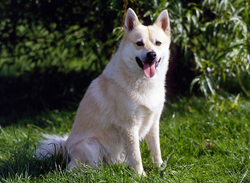Norwegian Buhunds are medium-sized dogs with thick wheaten or black coats. The outer coat is hard, thick, and smooth lying, and the undercoat is dense and soft. This breed has a black nose, pricked ears, and a tail that curls over the back. The eyes are oval and dark, and these dogs have wedge-shaped heads. Norwegian Buhunds measure 16 to 18.5 inches tall at the shoulder and weigh 26 to 40 pounds.
Norwegian Buhunds are talkative dogs and communicate through a variety of chortles, trills, barks, yips, and yodels.
Smart, affectionate, and cheerful dogs, Norwegian Buhunds make great companion animals for both singles and families. They are a high-energy breed that requires daily exercise, and they benefit from a yard or open space for running and playing. These dogs also make good watchdogs, although some tend to get a bit carried away in that role.
In its native Norway, the Norwegian Buhund's name means "farm dog." These dogs are also sometimes called Norwegian Sheepdogs or Norsk Buhunds.
As an affectionate, intelligent, and even-tempered breed, Norwegian Buhunds are a perfect fit for active people and families with older children. They get along well with cats and dogs they are raised with, but these dogs are very active and energetic and should be supervised at all times around small children and pets. They will not appreciate the tail and hair pulling or loud shrieking of young children, and the breed's rambunctiousness may cause it to knock over unsteady toddlers.
The breed's loud bark is best suited for rural or suburban living. Norwegian Buhunds are talkative dogs and communicate through a variety of chortles, trills, barks, yips, and yodels. Provided they have access to toys and a fenced yard, these dogs don't mind being on their own during the day. They do not usually suffer from depression and are good at amusing themselves, although separation anxiety may be an issue in individual dogs.
Norwegian Buhunds are active dogs that need regular exercise to remain physically and mentally healthy. However, if given enough exercise, the breed is calm and will enjoy relaxing on the couch for a movie or hanging out on a lazy weekend afternoon. Long walks on a leash and daily time spent playing ball or Frisbee are usually sufficient to burn up excess energy. Some dogs may enjoy hikes and slow runs.
Norwegian Buhunds are fairly healthy dogs with only a few common health problems. However, this does not guarantee that any individual dog will be free of health concerns or genetic diseases. Using only reputable breeders and adoption agencies helps ensure a healthy dog.
The breed is prone to congenital hip dysplasia, a condition that can negatively affect mobility and quality of life. Norwegian Buhunds are also more likely than some other dog breeds to develop cataracts. In some cases, this common eye problem may be treatable.
Routine veterinary care, regular exercise, and a balanced diet help ensure Norwegian Buhunds live a full and active life of up to 15 years.
Norwegian Buhunds are highly intelligent and respond well to training. This is a good thing, because without training, these dogs tend to be restless, stubborn, and destructive. The breed responds well to positive reinforcement techniques, such as food, play, and praise rewards, but training sessions must be kept short to prevent boredom and resistance. These dogs learn quickly and bore easily.
Norwegian Buhunds make good watchdogs, but they must be trained when to bark and when to keep their barking under control. Keeping them busy with exercise, puzzle toys, and trick training will help reduce hyperactivity and prevent many negative behaviors.
These dogs should be socialized from an early age to help them grow into confident and tolerant adults and to prevent overly fearful or suspicious behavior. Separation anxiety can be a problem in this breed. Training work with a professional to address this issue is beneficial.
Norwegian Buhunds are a low-maintenance breed when it comes to grooming. A quick brush every other day will keep the breed's coat clean and remove any dead hair before it ends up on clothing and furniture. These dogs shed year-round, with heavier shedding periods during the spring and fall. Daily brushing may be necessary during these times.
Norwegian Buhunds rarely require bathing. When it becomes necessary to remove something toxic or sticky from the coat, a pH-balanced canine shampoo and plenty of rinsing will prevent skin irritation and keep the coat healthy. Dogs with sensitive skin may require a special cleanser.
The nails need trimming every few weeks, and the teeth should be brushed with a canine toothpaste every day, when possible. Between brushings, a dental chew or drinking water additive will keep the gums and teeth healthy. Additionally, the ears should be checked at least weekly to look for wax accumulation and signs of infection.
Norwegian Buhunds are Spitz-type dogs bred to be working dogs. They were primarily used to herd livestock and as guardians of home, property, and family. Many of these dogs hunted bear and other large animals, including wolves.
The breed hails from Norway and may have first appeared among the Vikings. Bones of the Norwegian Buhund's ancestors have been discovered at burial sites of the Vikings, some of which date back to 900 AD. This placement is a strong indicator of their importance to the Viking people.
Today, these dogs are very popular as hearing assistant dogs and many are also involved in police work. In addition to being beloved family companions, Norwegian Buhunds perform very well in obedience and agility trials.
In 2009, the American Kennel Club officially recognized the Norwegian Buhund.

